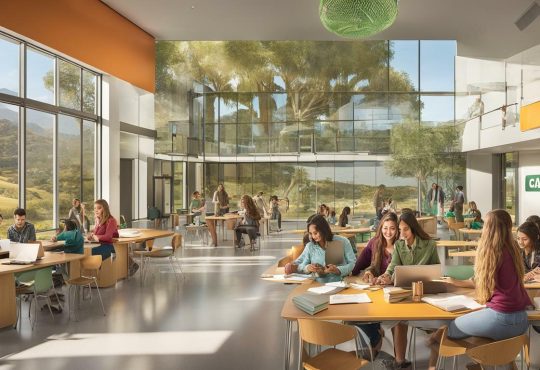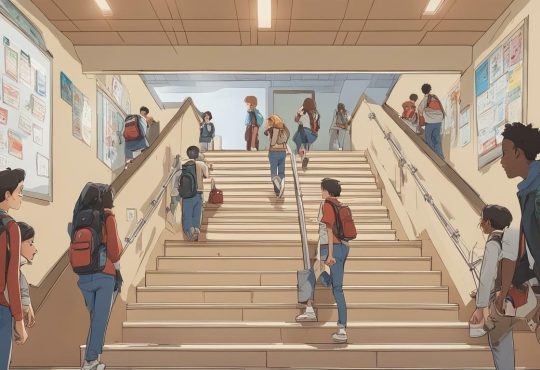
Why Do Schools Block Everything?
As we live in a digital age, the internet has become a prominent part of our daily lives. This is particularly evident in educational institutions, where students have access to vast amounts of online information. However, schools often choose to block certain websites or content, leaving students wondering why this is the case.
Content blocking, also known as internet filtering, refers to the process of restricting access to certain online content. Schools implement content filtering to control what students can access and ensure they are not exposed to inappropriate material. But what are the reasons for this approach, and what impact does it have on students?
Key Takeaways:
- Schools use content blocking, also known as internet filtering, to control what students can access online.
- Content blocking ensures that students are not exposed to inappropriate material, but it also restricts access to valuable online resources.
- The impact of content filtering on student learning outcomes can be both positive and negative.
- Schools face challenges in finding the right balance between internet freedom and safety.
Importance of Internet Filtering in Educational Institutions
Educational institutions have a responsibility to provide a safe and focused learning environment for their students. Internet filtering is an essential tool in achieving this goal. By restricting access to inappropriate content and potentially harmful websites, schools can protect their students from online threats and distractions.
The importance of internet filtering in educational institutions cannot be understated. With technology playing an increasingly important role in our daily lives, it is essential that schools implement measures to control online content and ensure that students are not exposed to inappropriate or harmful material.
Why Internet Filtering is Necessary
Internet filtering is necessary for several reasons. Firstly, it helps to protect students from harmful content such as online predators, cyberbullying, and pornography. By restricting access to such content, schools can help to ensure that their students are not exposed to harmful material that could have a negative impact on their development.
Secondly, internet filtering helps to maintain a focused learning environment by preventing students from accessing distractions such as social media, gaming sites, and other non-educational content. By blocking access to such sites, schools can encourage students to focus on their studies and reduce the risk of distractions that could hinder their academic progress.
Technology Restrictions in Educational Settings
Technology restrictions are an important aspect of internet filtering in educational settings. By implementing restrictions on technology usage, schools can ensure that the internet is being used for educational purposes only. This can include restrictions on social media sites, online shopping, and other non-educational resources.
Technology restrictions also help to ensure that students are not accessing harmful or inappropriate content. By blocking access to websites that contain such material, schools can protect their students from online threats and ensure that they are not exposed to material that could be harmful to their development.
Overall, internet filtering and technology restrictions are essential tools for creating a safe and focused learning environment in educational institutions. By implementing these measures, schools can help to protect their students from online threats and distractions, and ensure that they are able to focus on their studies and achieve their full potential.
Reasons for Restricted Website Access in Schools
There are several reasons why schools restrict access to certain websites. One of the primary reasons is to ensure that students do not encounter inappropriate content while browsing the internet. Schools aim to create a safe and secure learning environment, and content filtering is one way to achieve this goal.
Another reason for restricted website access is the potential for distractions. Students may be tempted to visit non-educational websites instead of focusing on their studies. By filtering out non-educational websites, schools can reduce the likelihood of students becoming distracted during class time.
Impact of Content Filtering on Student Learning
Content filtering in schools has a significant impact on student learning outcomes. While it can be argued that restricting access to certain websites promotes focused learning, it also limits students’ ability to explore valuable online resources.
On the positive side, content filtering can help students avoid distractions and remain on task. By blocking social media, gaming, and other non-educational websites, schools can create an environment that fosters productivity and academic achievement.
However, the downsides of content filtering cannot be ignored. With the internet being a valuable tool for research, writing, and collaboration, students may find themselves restricted in their ability to explore certain topics or access helpful resources. Additionally, content filtering may impact students’ ability to develop critical digital literacy skills needed in today’s world.
In some cases, content filtering may even result in decreased motivation, as students feel that their access to information and technology is limited. Without access to important websites that may aid in their learning, students may feel frustrated and less engaged with their coursework.
Overall, while content filtering can be beneficial, it is important for schools to consider the potential limitations it may impose on students’ learning and explore alternative approaches to internet management in educational settings.
Benefits and Drawbacks of Internet Censorship in Schools
While there are valid reasons for schools to restrict internet access, there are also potential drawbacks to such censorship. Here are some of the benefits and drawbacks of content filtering in educational institutions:
Benefits
- Improved Safety: Blocking inappropriate websites helps keep students safe from cyberbullying, harassment, and exposure to potentially harmful content.
- Reduced Distractions: Restricting access to social media, gaming, and other non-educational sites can help students stay focused on their studies.
- Compliance: Schools have a legal obligation to ensure that students are not exposed to inappropriate or illegal content, so filtering helps schools meet their legal responsibilities.
Drawbacks
- Limited Resources: Schools may not have the resources to properly filter all content, leading to gaps in the filtering system and potential exposure to inappropriate material.
- Access to Information: Students may be deprived of valuable educational resources and research materials that are blocked by the filtering system.
- Stifled Creativity: Over-restriction of internet access can stifle creativity and innovation, limiting students’ learning potential.
“Censorship reflects a society’s lack of confidence in itself.” – Potter Stewart
As with any debate, there are valid arguments on both sides of the issue of internet censorship in schools. Ultimately, it is up to educational institutions to strike a balance between providing a safe and focused learning environment, while also encouraging exploration and creativity.
Role of Parental Control Software in Educational Institutions
Parental control software has become an increasingly important tool for schools to manage internet access in a safe and effective way. With this software, administrators can monitor student activity online, block inappropriate content, and set limits on screen time. By involving parents in these efforts, schools can create a more collaborative and informed approach to content filtering.
One of the main benefits of parental control software is the ability to customize restrictions based on individual student needs. For example, younger students may need more restrictions on website access, while older students may require more flexibility for research purposes. Parental control software allows schools to create a tailored approach to internet filtering that meets the needs of different age groups and academic levels.
However, it’s vital to find the right balance between control and freedom in using technology. Parents should be aware of the software’s capabilities and limitations and be able to communicate with their children about safe and responsible internet usage. Schools must also ensure students have access to essential online resources while still maintaining a safe learning environment.
Moreover, schools must ensure that the use of parental control software does not create a false sense of security. These tools are not foolproof, and students may still be able to access inappropriate content outside of school hours or on personal devices. Therefore, schools must educate students and parents about the potential risks of technology and encourage responsible digital citizenship.
In conclusion, parental control software plays a critical role in shaping internet access in educational institutions. By involving parents in the process of content filtering and finding the right balance between control and freedom, schools can create a safe and productive learning environment. However, it’s important to remember that technology is constantly evolving, and schools must adapt their approach to content filtering to ensure it remains effective and relevant in the years to come.
Challenges of Balancing Internet Freedom and Safety in Schools
As schools seek to strike a balance between internet freedom and safety, they face a number of challenges. One key challenge is determining what content should be blocked to protect students from harm, while still allowing for educational exploration.
Another challenge is how to manage student productivity in the face of restricted access to certain websites. While website blocking may be necessary to keep students focused on learning activities, overly restrictive filters can hinder productivity and detract from the learning experience.
Furthermore, schools must also consider the implications of internet censorship on student privacy. Some argue that content filtering violates students’ right to access information and can limit their ability to engage in open inquiry and critical thinking.
Finally, schools must navigate the complex legal and ethical issues surrounding content filtering. They must balance the need to protect students from harmful content with the obligation to uphold First Amendment rights and maintain academic freedom.
Impact of Website Blocking on Student Productivity
While some argue that website blocking in schools can improve student focus and productivity by reducing distractions, others argue that it can hinder students’ ability to learn and explore information.
On the one hand, website blocking can prevent students from accessing social media and other non-educational content during school hours, allowing them to concentrate on their studies. Additionally, it can reduce the risk of cyberbullying and exposure to inappropriate content, creating a safer environment for students to learn.
On the other hand, website blocking can limit students’ access to valuable online resources that could aid in their education. For example, if a student is researching a topic for a school project and is unable to access certain websites due to content blocking, they may not be able to gather all the information they need to complete their assignment effectively. This limitation could potentially hinder their learning and affect their grades.
Moreover, website blocking can lead to frustration and decreased motivation among students. If they are not able to access the websites they need for their assignments or personal interests, they may feel discouraged and uninterested in learning.
In conclusion, while website blocking can have both positive and negative impacts on student productivity, it is essential for schools to strike a balance between providing a safe learning environment and giving students access to valuable online resources.
Alternatives to Website Blocking in Educational Settings
While content filtering can be an effective way to protect students online, some educators and parents argue that it can be too limiting and hinder educational exploration. Here are some alternative approaches that schools can consider:
Educational Filters:
Instead of completely blocking websites, schools can use educational filters that limit access to specific types of content while still allowing students to explore and learn online. These filters can be customized to align with the school’s educational goals and values.
Teaching Responsible Internet Usage:
Another approach is to teach students responsible internet usage and digital citizenship. By educating students on appropriate online behavior, they can develop the skills and judgment necessary to navigate the internet safely and effectively.
Implementing Digital Citizenship Programs:
Many schools are adopting digital citizenship programs that focus on developing students’ digital literacy skills and teaching them how to use technology responsibly. These programs often cover topics like online safety, privacy, cyberbullying, and appropriate social media use.
It’s important for schools to explore alternative approaches to website blocking to ensure that students have access to a wide range of online resources and opportunities for educational exploration. With the right digital citizenship education and tools, students can develop the skills and judgment necessary to navigate the internet safely and responsibly.”
Future Directions in Content Filtering in Schools
The debate around internet censorship in educational institutions is ongoing, and with advancing technology, the conversation is becoming more complex. As schools seek to provide a safe and productive learning environment, it is crucial to examine future directions in content filtering.
Emerging Technologies
As technology continues to evolve, new solutions for content filtering are likely to emerge. For example, machine learning algorithms can analyze web content in real-time to determine whether it is appropriate for students. Schools may also consider implementing advanced filtering techniques, such as URL filtering and IP blocking, to provide more granular controls over internet access.
Evolving Policies
The policies and regulations surrounding internet access in educational institutions are likely to evolve in the coming years. Some states have already passed laws mandating internet filtering in schools, while others are considering similar legislation. As policies change, schools will need to adapt to ensure compliance.
Striking the Right Balance
The ultimate goal of content filtering in educational institutions is to strike the right balance between internet freedom and safety. In the future, schools may focus more on teaching responsible internet usage rather than outright blocking of web content. Digital citizenship programs, which aim to educate students on responsible online behavior, may become more prevalent in schools.
As we look to the future of content filtering in schools, it is clear that the conversation is far from over. As technology evolves and policies change, schools must continue to adapt in order to provide a safe and productive learning environment for their students.
Conclusion
Overall, schools block certain websites and content in order to create a safe and focused learning environment for students. While internet filtering and technology restrictions are important, it’s important to recognize the challenges of balancing internet freedom and safety.
Through this article, we have explored the reasons why schools restrict access to certain websites, the impact of content filtering on student learning outcomes, and the benefits and drawbacks of internet censorship in educational institutions. We have also discussed the role of parental control software and some alternative approaches to complete website blocking.
As we move forward, it will be interesting to see how schools adapt to emerging technologies and evolving policies in order to strike the right balance between internet access and safety. In the meantime, it’s important to continue the ongoing debate surrounding internet access in educational institutions and to involve all stakeholders in the process of content filtering.



